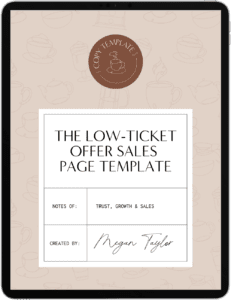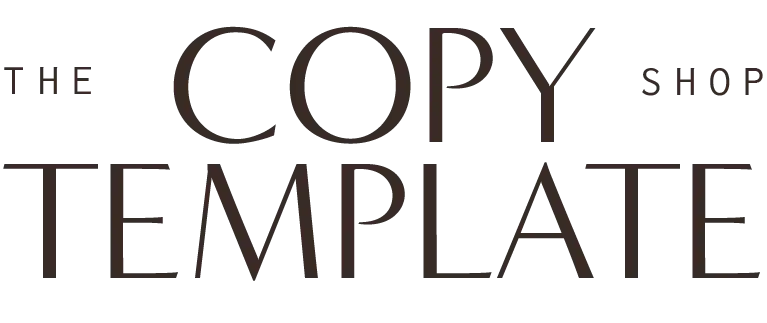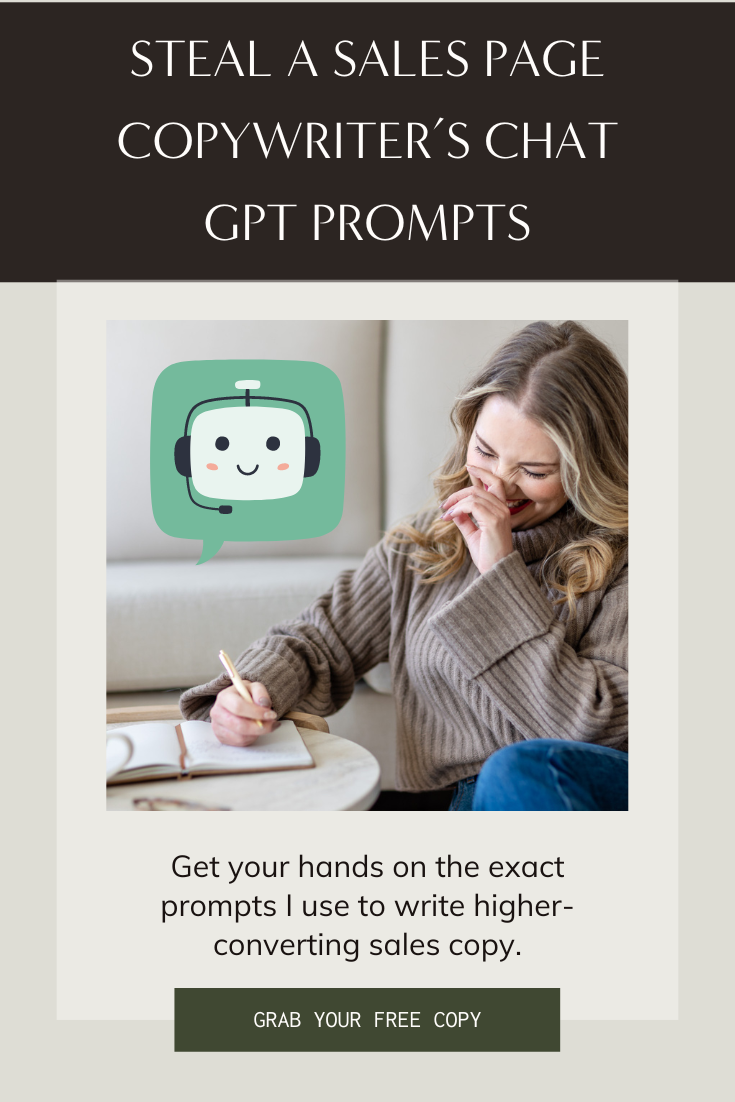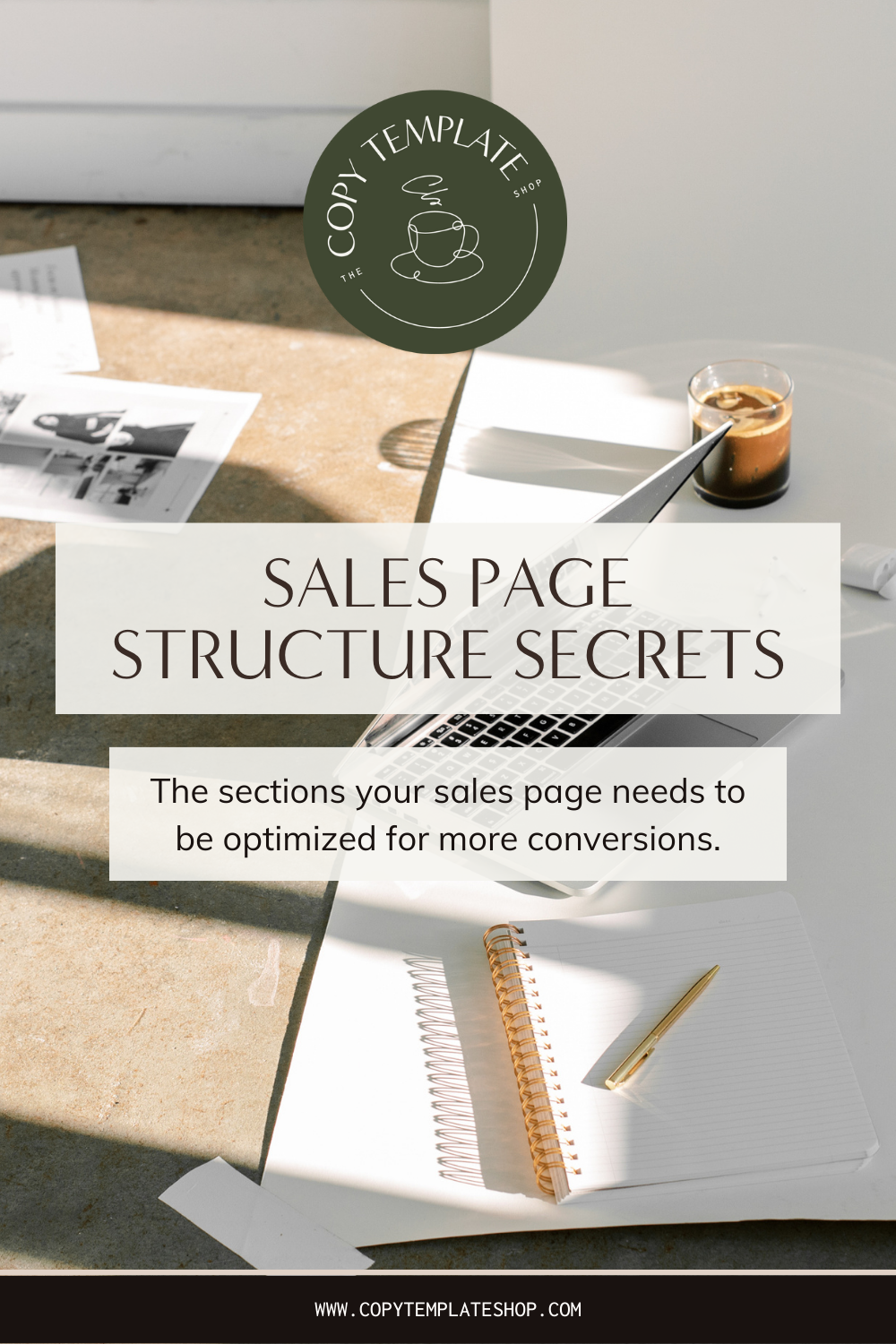Whether you’re writing your first-ever sales page for your online business, or looking to refine an existing sales page for one of your proven offers, understanding the right sales page structure is critical for making more sales.
The sections you decide to include on your sales page, and the order you put them in, are the backbone of how effectively you communicate your offer, connect with your audience, and ultimately drive those conversions.
As a copywriter who’s been writing high-converting sales pages for 8+ years now, I can safely say that no two sales pages are (or should be) identical. But, there are some commonalities!
This blog post will guide you through structuring your next sales page, so you can connect with potential buyers and lead them towards the sale. Prefer to listen than read? Get a quick overview with this episode from The Copy Dates Podcast:
How your offer and audience affect your sales page structure
Think about the last time you bought something under $50. Then think about the last time you made a big investment — say, $1,000+. Chances are, the decision-making process behind each of those purchases was vastly different, right? Well, the same thing goes for your business.
The sections that you need on your sales page depend heavily on the decision-making process involved, which means you need to consider things like who you’re selling to, what type of offer you’re selling, where traffic to that sales page is coming from, and how much trust you’ve already established with your reader.
While this guide will give you some high-level advice on how to structure your sales page, please keep in mind that this can all change depending on what you’re selling and who you’re selling it to.
This is exactly why we don’t offer a ‘one-size-fits-all’ sales page template here at The Copy Template Shop. Instead, our sales page copy templates are offer-specific, keeping in mind the buyer psychology and decision-making happening behind each type of offer.
The myth of price and page length
A lot of people believe that a low-ticket offer (generally something $100 or less) is easier to sell and therefore needs a shorter sales page. But in my experience, the opposite is actually true.
Most (though not all) of the time, we’re selling our lower-ticket offers to first-time buyers, such as people on our email list who have never bought from us, or brand new leads coming from Facebook ads.
These first-time buyers haven’t always had time to get to know us; so, they need additional information to trust us or trust that our product works. For example, they’ll need extra social proof (testimonials and reviews), and potentially a longer bio section where you talk about your expertise and authority in this area. This might mean you need more copy on your sales page compared to your higher-ticket programs.
Price isn’t even the deciding factor here: the solution you’re selling is. A $47 one-time offer has the same upfront cost as a $47 monthly membership program; but because the offer, target audience, and transformation are different, your sales page will need a slightly different structure.
The 3 things your sales page needs to address
Still with me? Great. The main reason why the sales page structure differs between offers is because the target audience for each offer will have different motivations to buy. So, before I give you some tips on how to structure your sales page, let’s talk about what to consider before sitting down to write, and how each of these things will inform which sections you’ll need to include.
1. Articulate the problem your offer solves
If your business has different offers, a potential buyer must be able to differentiate between them and choose the best solution for them. That’s why understanding and communicating the specific problem your offer solves is foundational to the structure of your sales page.
Yes, all of your offers will likely solve similar (ish) problems and be related to one another. For example, if you’re a website designer, you may have some done-for-you design services, a consultation-like service, and web design templates. Each of these solutions helps your client end up with a beautifully designed website, but the problem each offer solves isn’t identical.
Each of the offers in your business should target a specific, distinct problem, and the sections you include on your sales page need to speak to that problem. Ask yourself things like:
- What pain points are my target audience experiencing? How is this problem challenging them in their personal life or business?
- What examples or scenarios can my target audience see themselves in? Are there any stories I can share to show that I ‘get them’, to increase relatablity and engagement?
2. Highlight the outcome provided by your solution
Because each offer solves a specific problem, it should also promise a unique transformation or outcome.
For example, let’s say that you’re a social media manager selling resources to help small business owners with their reach on Instagram. Maybe you sell a low-ticket $9 guide and a monthly $29 membership, both helping people create engaging Instagram reels.
While the end outcome of these offers is similar, we have to consider that a low-ticket offer usually provides a simple quick win, whereas a monthly membership is an ongoing commitment and transformation.
When mapping out your sales page structure, consider the journey and results that you’re promising. Ask yourself things like:
- What specific, tangible changes will my client see from my offer? How is it going to change their day-to-day life or business?
- What timeframe can they expect to see these changes in, and how have I structured my offer to support that journey?
- What evidence do I have that this outcome is possible? Are there any success stories or testimonials I can share to make this more obvious?
3. Understand and speak to your buyer’s motivations
Finally, it’s also important to understand your buyer’s motivations for considering your offer. Not only are the problem and solution very unique and specific to your offer but the questions and hesitations someone may have around investing in it are also unique.
For example, before investing $3,000 in a done-for-you service, you might ask yourself questions like:
- How much experience does this person have?
- What are their qualifications?
- What kind of results have they helped other people achieve?
- What’s the typical return on investment for this kind of service?
Whereas if you were investing in a $30 low-ticket product, you might ask yourself questions like:
- Is this person reputable and trustworthy?
- Is this something I can take action on right now, or will it sit in my inbox until I forget about it?
- Do I have the time, energy, and other resources right now whatever this is going to teach me?
When sitting down to structure your sales page, I want you to think about the potential questions your buyers are going to have about your offer and try to pre-empt them within your sales page copy.
- If you know they’re going to need evidence that this works, what social proof can you leverage?
- If you know they’re going to have questions about your authority and expertise, what can you include to make that clear?
- If you know they’ll care about the tangible features, how can you describe them in a compelling way?
Essential sales page sections for conversions
The purpose of your sales page is to deliver most (if not all) of the information a potential buyer needs to make an informed decision about whether or not your offer is the right fit for them. Getting clear on things like the problem your offer solves, the solution it provides, and potential questions or hesitations your buyer will have about it is a great place to start. But to maintain their attention once we’ve grabbed it, and to lead them toward the sale, we need to consider the flow and structure of our sales page.
Before I start to write a sales page for a client, the first thing I do is outline the sections I’m going to need to deliver all the important messaging around the offer. This helps me make sure the sales page will have a clear, natural, and easy-to-follow narrative.
One of the easiest ways to think about this is the same way that we used to write essays in English class. Just like a good essay, a good sales page needs to have a beginning, a middle, and an end.
The Beginning: Capture Attention & Build Interest
Think of the first few sections of your sales page as the introduction to your story. The copy here needs to draw the reader in, capture their initial interest, and make them curious enough to want to keep reading.
The key sections in this part of your sales page structure are:
- The hero section. This is usually made up of an attention-grabbing, benefit-driven headline, a subheadline that provides some extra context, and an immediate call to action. Somebody should be able to read this first section of your sales page and immediately get a sense of whether this offer is right for them.
- The ‘nightmare’ section. This is where you address the reader’s problem and describe the pain points that are impacting their day-to-day life. We recommend doing this in an empathetic way: you want to use pain points to make your reader feel understood, not pressured
- The ‘dream’ section. Acting as the opposite of your ‘nightmare’ section, the copy here should paint a picture of what their life and/or business would look like if those problems were no longer an issue. Try to get to the root of what your buyer actually wants, here and now.
The Middle: Inform, Engage & Showcase Value
The middle part of your sales page is where the real storytelling around your offer happens. This is where we set the tone and give the reader all the information they need to understand what you’re trying to sell and how it’s going to happen.
The key sections in this part of your sales page structure are:
- The offer presentation. Introduce your offer to the reader, ideally with some sort of visual mockup and a powerful promise statement. How can you summarize the transformation your offer delivers in a single statement?
- The secret sauce. Explain what it is that makes this offer different from other solutions available on the market, including things the reader may have tried before. This is a great place to talk about a signature framework or proven process you’ve developed.
- The ‘what’s in it for me?’ Tell your readers about the things they’re going to learn, experience, or do with your offer. Be sure to tie those benefits back to the pain points and desires you outlined near the top of the sales page.
- The features. What are your readers going to get if they buy your offer? It’s important to present all of the things that are included in their purchase, but link those features to a clear benefit. For each feature, ask yourself: “So what? Why does this matter?”
- Lots of social proof. What testimonials, case studies, reviews, and other third-party endorsements can you lean on to back up these claims about your offer?
- The pricing. If you want your sales page to convert, it’s important to be clear and upfront about the investment. Some offers can benefit from copy that positions the investment against alternative solutions here.
The End: Address Hesitations & Encourage Action
Finally, everyone likes a happy ending. The last few sections of your sales page are where you can soothe your readers’ worries, wrap up your message, and make sure that there’s a clear call to action.
The key sections in this part of your sales page structure are:
- The guarantee. If you have some sort of warranty or money-back guarantee for your offer, be sure to give it its own section on the sales page.
- The person behind the offer. Let the reader know who they’re putting their trust in by buying this offer. What makes you a credible source of information? What experience do you have in this area that makes you someone worth learning from?
- The “is it for me?” Even after reading all of this compelling copy, there are still going to be readers who aren’t quite convinced that this offer is for them; so, spell it out for them! Get clear on who your offer is and isn’t right for, and put that on your sales page.
- Additional social proof. What additional testimonials can you share to back up your claims? What about media features or logos from notable clients that lend you credibility?
- The FAQ. An effective FAQ section should go way beyond answering basic questions like “do you offer a payment plan?” Rather than reiterating details they can find elsewhere on the page, use this space to soothe hesitations and continue selling.
- The urgency. Does your offer have any built-in urgency, such as an expiring discount or bonus? If not, can you create natural urgency by explaining the cost of waiting to invest in your offer? Why is NOW the time?
- The final call to action. Be sure to end your sales page with a final invitation to buy your offer.
Seal the deal: Perfect your sales page structure for peak conversions
Remember: the structure of your sales page is so much more than just a layout or outline. By mapping out your sales page sections ahead of time, you’re ensuring that you’re taking your reader on a journey from recognizing a problem, to seeing the solution in your offer, to ultimately taking action.
Your sales page represents that crucial sales conversation that needs to happen for potential buyers to understand you can support their needs. By articulating their problem, highlighting their desired outcome, and understanding their motivations, you've laid the groundwork for a compelling narrative that resonates deeply with good-fit buyers.
Each section of your sales page — from the beginning through the middle and to the end — serves a purpose. It captures attention, builds interest, addresses concerns, and guides your audience toward making a decision.
As you sit down to write your next sales page, keep these insights in mind. Test, refine, and adjust based on the responses you receive. The beauty of online entrepreneurship is the ability to iterate and evolve. Your sales page is a living document, and it can absolutely be optimized down the road to better serve your audience and your business.
Your sales page structure, done for you!

As you can see, there are a lot of considerations that must go into structuring your sales page. Want us to take all of the guesswork out of that for you? Check out our offer-specific sales page copy templates.
Our situation-specific templates strategically support your reader’s decision-making process, so they feel informed (and excited to type in their credit card details).





2 Comments on Sales Page Structure Secrets: A Guide for More Conversions
Comments are closed.